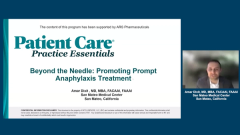
Why Epinephrine Is the Gold Standard in Treating Anaphylaxis
A panelist discusses how epinephrine is definitively the first-line treatment for anaphylaxis regardless of severity, emphasizing that delayed administration is associated with poor outcomes, including abnormal vital signs and increased risk of hospitalization.
Episodes in this series

Video content above is prompted by the following:
This segment focuses on the critical importance of epinephrine as first-line therapy for anaphylaxis, with 94% of attendees correctly identifying it as the primary treatment. Dixit emphasizes that epinephrine should be administered regardless of reaction severity due to its well-tolerated profile and century-long established use. He contrasts this with antihistamines, which work more slowly (10-plus minutes) and fail to address life-threatening cardiac and respiratory symptoms of anaphylaxis.
Dixit briefly references epinephrine’s 100-year history and well-documented pharmacology without delving into technical details. Another polling question reveals that most attendees recognize multiple benefits of early epinephrine administration: reducing severe reaction risk, preventing progression to life-threatening stages, decreasing need for additional interventions, and avoiding poor outcomes associated with delayed treatment.
The presentation then examines consequences of delayed treatment, including abnormal vital signs (decreased blood pressure, increased respiratory rate), need for multiple epinephrine doses, increased hospitalization risk, and heightened risk of biphasic anaphylaxis. Dixit explains that biphasic anaphylaxis occurs when patients experience a second anaphylactic reaction after the initial episode seems resolved, emphasizing that both reactions stem from the same trigger, not from different allergens.
Newsletter
Enhance your clinical practice with the Patient Care newsletter, offering the latest evidence-based guidelines, diagnostic insights, and treatment strategies for primary care physicians.














































































































































































































































































